Independence
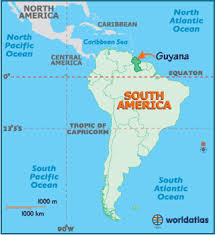
 Guyana achieved independence from Britain on May 26, 1966. Upon
independence Guyana boasted one of the most educated and affluent citizenry of all the Caribbean. It also had rich bauxite deposits, extensive timberlands, and an excellent climate for rice and sugar cane.
Years of political turmoil, initiated by the nations founders exacerbated racial divisions, fueled economic instability, created an exodus of its educated class (brain drain), and destroyed any hope of a great birth. Today, she attempts to shed
this legacy of political strife and economic backwardness to assume her rightful place as a jewel of the Caribbean.
Guyana achieved independence from Britain on May 26, 1966. Upon
independence Guyana boasted one of the most educated and affluent citizenry of all the Caribbean. It also had rich bauxite deposits, extensive timberlands, and an excellent climate for rice and sugar cane.
Years of political turmoil, initiated by the nations founders exacerbated racial divisions, fueled economic instability, created an exodus of its educated class (brain drain), and destroyed any hope of a great birth. Today, she attempts to shed
this legacy of political strife and economic backwardness to assume her rightful place as a jewel of the Caribbean.
Land of Many Waters
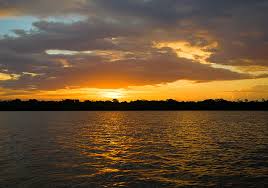
The National Flag
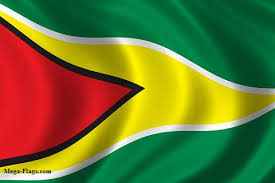 The Golden Arrowhead, Guyana's National Flag has FIVE symbolic colors -- GREEN represents the agricultural and forested nature of Guyana,
WHITE symbolizes the rivers and water potential of the country, a GOLDEN arrow represents Guyana's mineral wealth, BLACK portrays the endurance that will sustain the forward thrust of the Guyanese people and RED represents
the zeal and dynamic nature of nation-building which lies before the young and independent Guyana.
The Golden Arrowhead, Guyana's National Flag has FIVE symbolic colors -- GREEN represents the agricultural and forested nature of Guyana,
WHITE symbolizes the rivers and water potential of the country, a GOLDEN arrow represents Guyana's mineral wealth, BLACK portrays the endurance that will sustain the forward thrust of the Guyanese people and RED represents
the zeal and dynamic nature of nation-building which lies before the young and independent Guyana.
The Flag was designed by Whitney Smith, Director of the Flag Centre, Florida, U.S.A.
Seeds of Conflict
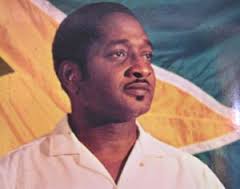 Linden Forbes Sampson Burnham was Guyana's first head of state and
governed the new nation until his death. He is considered Guyana's greatest political mind. He was born February 20, 1923 in Kitty, British Guiana and died August 6, 1985 in Georgetown, Guyana. He formed the People's Progressive
Party with Cheddi Jagan. His abrupt departure from the People's Progressive Party was fueled by his fear and distrust of the intentions of East Indian
leader Cheddi Jagan. Their political rift sowed the seeds of the deep racial divisions that plague Guyanese politics to this day.
Linden Forbes Sampson Burnham was Guyana's first head of state and
governed the new nation until his death. He is considered Guyana's greatest political mind. He was born February 20, 1923 in Kitty, British Guiana and died August 6, 1985 in Georgetown, Guyana. He formed the People's Progressive
Party with Cheddi Jagan. His abrupt departure from the People's Progressive Party was fueled by his fear and distrust of the intentions of East Indian
leader Cheddi Jagan. Their political rift sowed the seeds of the deep racial divisions that plague Guyanese politics to this day.
Coat-of-Arms
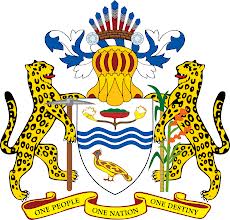 The national Coat-of-Arms of Guyana is a composite of motifs suggested in separate designs by three Guyanese artists. The design is interpreted as follows:
The national Coat-of-Arms of Guyana is a composite of motifs suggested in separate designs by three Guyanese artists. The design is interpreted as follows:
The Amerindian head-dress symbolizes the Amerindians as the indigenous people of the country. The two diamonds at the side of the head-dress represent the country's mining industry. The helmet is the monarchial insignia. The two jaguars holding a pick axe, a sugar cane
and a stalk of rice symbolize labor and the two main agricultural industries of the country - sugar and rice. The shield which is decorated with the National Flower, the Victoria Regia Lily, is to protect the nation. The three blue wavy lines represent the many waters of Guyana.
The Canje Pheasant, the National Bird, at the bottom of the shield represents a rare bird found principally in this part of the world and also the rich fauna of Guyana. The streamer below the shield bears the Nation's Motto
"ONE PEOPLE, ONE NATION, ONE DESTINY".
The Coat of Arms was selected on the recommendation of the National History and Arts Council and
approved by the College of Arms, England. It was accepted by the House of Assembly on Friday,
25th February, 1966.
Destiny Denied
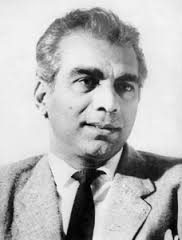 Cheddi Berret Jagan was born March 22, 1918 in Berbice, Guyana and died on February 15, 1997 at Walter Reed Hospital, USA. Jagan won in colonial
elections and served briefly in 1953. However his flirtations with communism alarmed the USA and Great Britain. This prompted a military intervention that forced him
from office after serving only 133 days. Despite winning a plurality of the vote in the 1964 elections, Burnham with his new PNC party was
able to form a coalition with the conservative United Force and seize the reigns of government.
Cheddi Berret Jagan was born March 22, 1918 in Berbice, Guyana and died on February 15, 1997 at Walter Reed Hospital, USA. Jagan won in colonial
elections and served briefly in 1953. However his flirtations with communism alarmed the USA and Great Britain. This prompted a military intervention that forced him
from office after serving only 133 days. Despite winning a plurality of the vote in the 1964 elections, Burnham with his new PNC party was
able to form a coalition with the conservative United Force and seize the reigns of government.
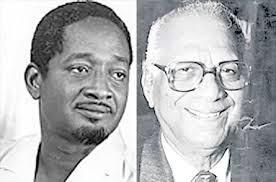 With the so called "communist" Jagan out of the way and the country under Burnham's leadership, Great Britain and the U.S. could now grant Guyana independence. Many argue that were it not for Burnham taking the reigns of leadership, the two powers would have never granted Guyana independence, they so worried that Jagan would become the "Fidel Castro" of South America.
With the so called "communist" Jagan out of the way and the country under Burnham's leadership, Great Britain and the U.S. could now grant Guyana independence. Many argue that were it not for Burnham taking the reigns of leadership, the two powers would have never granted Guyana independence, they so worried that Jagan would become the "Fidel Castro" of South America.
It would take 28 years of hard struggle before Jagan would be returned to power, by then his chief rival Burnham had been dead for more than 7 years. Guyana's once vibrant economy had
been shattered and her educated middle class had fled the country. More importantly the People's Progressive Party had devolved into nothing more than a East-Indian party bent on righting past wrongs. In many ways living up to the fears that had prompted Burnham to flee the party in the first place.
It was clear that the years of struggle had taken a toll on the man, the country and his party.
He served 7 years before he died after having an heart attack.
Cuffy-National Hero
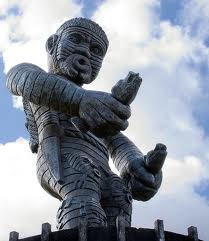 The anniversary of the Cuffy slave rebellion, 23rd of February, has been Republic Day in Guyana since 1970. Cuffy was an Akan man who was captured in his native West Africa and sold into slavery.
In 1763 he led a successful revolt of more than 2,500 slaves in what is present day Berbice, Guyana. Cuffy is commemorated in the 1763 Monument in
the Square of the Revolution in the capital Georgetown.
The anniversary of the Cuffy slave rebellion, 23rd of February, has been Republic Day in Guyana since 1970. Cuffy was an Akan man who was captured in his native West Africa and sold into slavery.
In 1763 he led a successful revolt of more than 2,500 slaves in what is present day Berbice, Guyana. Cuffy is commemorated in the 1763 Monument in
the Square of the Revolution in the capital Georgetown.

 Guyana achieved independence from Britain on May 26, 1966. Upon
independence Guyana boasted one of the most educated and affluent citizenry of all the Caribbean. It also had rich bauxite deposits, extensive timberlands, and an excellent climate for rice and sugar cane.
Years of political turmoil, initiated by the nations founders exacerbated racial divisions, fueled economic instability, created an exodus of its educated class (brain drain), and destroyed any hope of a great birth. Today, she attempts to shed
this legacy of political strife and economic backwardness to assume her rightful place as a jewel of the Caribbean.
Guyana achieved independence from Britain on May 26, 1966. Upon
independence Guyana boasted one of the most educated and affluent citizenry of all the Caribbean. It also had rich bauxite deposits, extensive timberlands, and an excellent climate for rice and sugar cane.
Years of political turmoil, initiated by the nations founders exacerbated racial divisions, fueled economic instability, created an exodus of its educated class (brain drain), and destroyed any hope of a great birth. Today, she attempts to shed
this legacy of political strife and economic backwardness to assume her rightful place as a jewel of the Caribbean.
 The Golden Arrowhead, Guyana's National Flag has FIVE symbolic colors -- GREEN represents the agricultural and forested nature of Guyana,
WHITE symbolizes the rivers and water potential of the country, a GOLDEN arrow represents Guyana's mineral wealth, BLACK portrays the endurance that will sustain the forward thrust of the Guyanese people and RED represents
the zeal and dynamic nature of nation-building which lies before the young and independent Guyana.
The Golden Arrowhead, Guyana's National Flag has FIVE symbolic colors -- GREEN represents the agricultural and forested nature of Guyana,
WHITE symbolizes the rivers and water potential of the country, a GOLDEN arrow represents Guyana's mineral wealth, BLACK portrays the endurance that will sustain the forward thrust of the Guyanese people and RED represents
the zeal and dynamic nature of nation-building which lies before the young and independent Guyana.

 The national Coat-of-Arms of Guyana is a composite of motifs suggested in separate designs by three Guyanese artists. The design is interpreted as follows:
The national Coat-of-Arms of Guyana is a composite of motifs suggested in separate designs by three Guyanese artists. The design is interpreted as follows:

 The anniversary of the Cuffy slave rebellion, 23rd of February, has been Republic Day in Guyana since 1970. Cuffy was an Akan man who was captured in his native West Africa and sold into slavery.
In 1763 he led a successful revolt of more than 2,500 slaves in what is present day Berbice, Guyana. Cuffy is commemorated in the 1763 Monument in
the Square of the Revolution in the capital Georgetown.
The anniversary of the Cuffy slave rebellion, 23rd of February, has been Republic Day in Guyana since 1970. Cuffy was an Akan man who was captured in his native West Africa and sold into slavery.
In 1763 he led a successful revolt of more than 2,500 slaves in what is present day Berbice, Guyana. Cuffy is commemorated in the 1763 Monument in
the Square of the Revolution in the capital Georgetown.